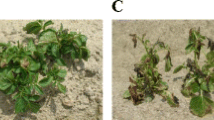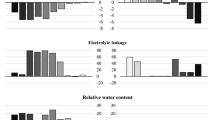Abstract
Electrolyte leakage was measured in “hardened” and “nonhardened” leaves of three potato species, Solanum tuberosum L., S. acaule Bitt. and S. commersonii Dun., and one interspecific cross, “Alaska Frostless” (S. acaule x S. tuberosum) when exposed to various subzero temperatures. The leaves were undercooled (no ice present) from 0°C to -12.5°C for 45 min and to-4°C for up to 10 d. Regardless of the degree of undercooling no injury was observed in any of the potatoes, “hardened” or “nonhardened”, for up to 12 h. After 5 d, however, electrolyte leakage was observed in “hardened” S. tuberosum, S. acaule and S. commersonii, and in “nonhardened” “Alaska Frostless”. After 10 d exposure all potatoes, “hardened” and “nonhardened”, showed a significant amount of electrolyte leakage as compared to their controls kept at 0°C for 10 d.
Similar content being viewed by others
References
Adir, C.R. (1968) Testing rice seedlings for cold water tolerance. Crop Sci. 8, 264–265
Arny, C.D., Lindow, S.E., Upper, C.D. (1976) Frost sensitivity of Zea mays increased by application of Pseudomonas syringae. Nature 262, 282–284
Aronsson, A., Eliasson, L. (1970) Frost hardiness in Scots pine. I. Conditions for test on hardy plant tissues and for evaluation of injuries by conductivity measurements. Stud. For. Suec. 77, 1–30
Asahina, E. (1954) A process of injury induced by the formation of frost on potato sprout. Low Temp. Sci. B 11, 13–21
Burke, M.J., Gusta, L.V., Quamme, H.A., Weiser, C.J., Li, P.H. (1976) Freezing and injury in plants. Annu. Rev. Plant Physiol. 27, 507–528
Burton, W.G. (1981) Challenges for stress physiology in potato. Am. Potato J. 58, 3–14
Chen, H.H., Li, P.H. (1980) Characteristics of cold acclimation and deacclimation in tuber bearing Solanum species. Plant Physiol. 65, 1146–1148
Chen, P.M., Burke, M.J., Li, P.H. (1976) The frost hardiness of several Solanum species in relation to the freezing of water, melting point depression, and tissue water content. Bot. Gaz. 137, 313–317
Dexter, S.T., Tottingham, W.E., Graber, L.F. (1932) Investigations of hardiness of plants by measurement of electrical conductivity. Plant Physiol. 7, 63–78
George, M.F., Burke, M.J., Weisert, C.J. (1974) Supercooling in overwintering azalea flower buds. Plant Physiol. 54, 29–35
Hudson, M.A., Idle, D.B. (1962) The formation of ice in plant tissues. Planta 57, 718–730
Levitt, J. (1980) Responses of plants to environmental stresses Academic Press, New York
Linder, J. (1915) Über den Einfluß günstiger Temperaturen auf gefrorene Schimmelpilze (Zur Kenntnis der Kälteresistenz von Aspergillus niger). Jahrb. Wiss. Bot. 55, 1–52
Lindow, S.E., Arny, D.C., Upper, C.D., Barchet, W.R. (1978) The role of bacterial ice nuclei in frost injury to sensitive plants. In: Plant cold hardiness and freezing stress, pp. 249–263, Li, P.H., Sakai, A., eds. Academic Press, New York
Lindstrom, O.M., Carter, J.V. (1980) Assessing the freezing injury of cold hardened supercooled potato leaves. (Abstr.) Plant Physiol. 65, Suppl., 46
Lindstrom, O.M., Carter, J.V. (1983) Assessment of freezing injury of cold-hardened undercooled leaves of Solanum commersonii. Cryo-Lett. 4, 361–370
Lyons, J.M., Raisson, J.K., Steponkus, P.L. (1979) Adaptations to chilling: Survival, germination, respiration and protoplasmic dynamics. In: Low temperature stress in crop plants: The Role of the membrane, pp. 565, Lyons, J.M., Graham, D., Raison, J.K., ed. Academic Press, New York
Molisch, H. (1897) Untersuchungen über das Erfriere der Pflanzen. G. Fischer, Jena. Engl. transln. in Cryo-Lett. 3 331–390 (1982)
Onoda, N. (1937) Mikroskopische Beobachtungen über das Gefrieren einiger Pflanzenzellen in flüssigem Paraffin. Bot. Inst. Kais. Univ. Kyoto, Bot. Zool. 5, 1845–2188
Palta, J.P., Levitt, J., Stadelmann, E.J. (1977) Freezing injury in onion bulb cells. II. Post-thawing injury or recovery. Plant Physiol. 60, 398–401
Quamme, H.A., Evert, D.R., Stushnoff, C., Weiser, C.J. (1972) A versatile temperature control system for cooling and freezing biological materials. Hort. Science 7, 24–25
Schnell, R.C. (1974) Biogenic sources of atmospheric ice nuclei Report No. AR111, Dept. of Atmosph. Resources, Coll. of Eng., University of Wyoming, Laramie, USA
Sukumaran, N.P., Weiser, C.J. (1972) Freezing injury in potato leaves. Plant Physiol. 50, 564–567
Tsunoda, K., Fujimura, K., Nakahori, T., Oyomodo, Z. (1968) Studies on the testing method for cooling tolerance in rice plants. I. An improved method by means of short term treatments with cool and deep water. Jpn. J. Breed. 18, 33–40
Author information
Authors and Affiliations
Additional information
Scientific Journal Series Paper No. 13842 of the Minnesota Agricultural Experiment Station, St. Paul, Minn
Rights and permissions
About this article
Cite this article
Lindstrom, O.M., Carter, J.V. Injury to potato leaves exposed to subzero temperatures in the absence of freezing. Planta 164, 512–516 (1985). https://doi.org/10.1007/BF00395968
Received:
Accepted:
Issue Date:
DOI: https://doi.org/10.1007/BF00395968




